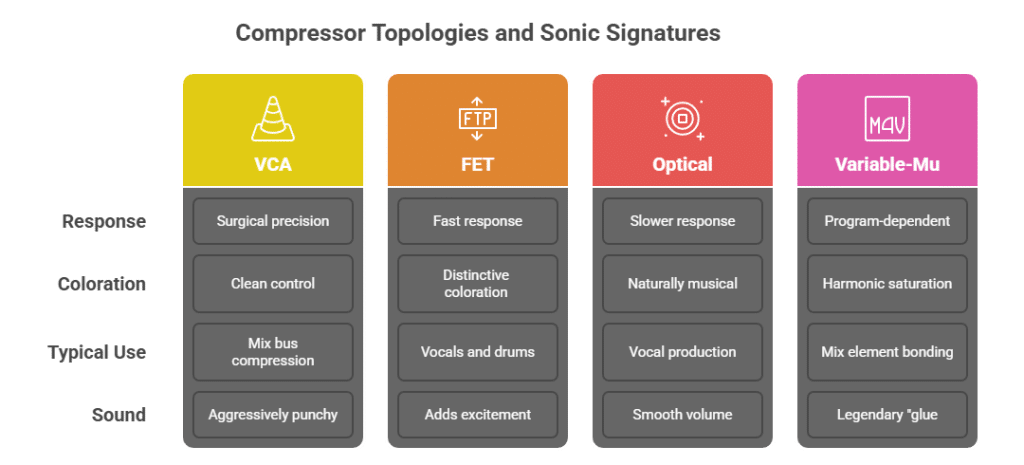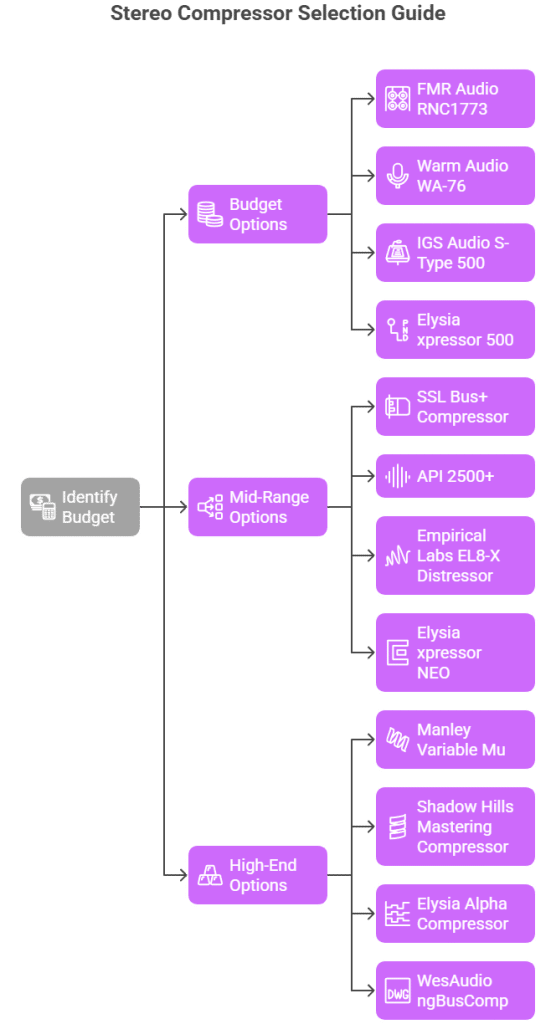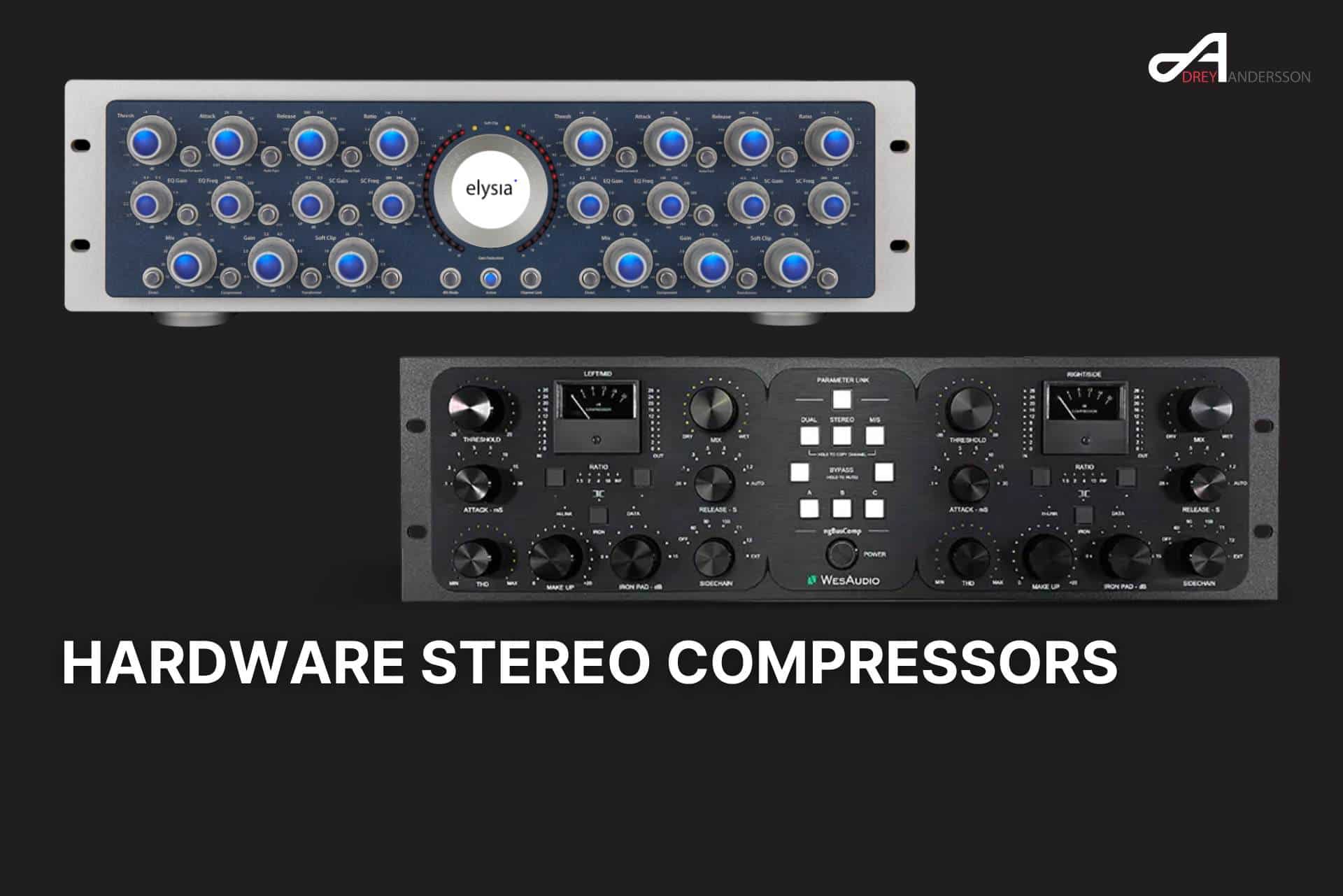You’re staring at your mix, wondering why it sounds disconnected—individual tracks fighting each other instead of working together as a cohesive whole. You’ve tried plugins, automation, and EQ tweaks, but something’s still missing. What you need is the secret weapon that’s glued together countless hit records: a stereo compressor. More specifically, you need to understand how a stereo audio compressor can transform your mixes from a collection of separate elements into a unified, professional-sounding production.
If you’ve ever wondered whether hardware compression is worth the investment in our digital age, you’re about to discover why legendary engineers still reach for these analog machines. Hardware stereo compressors don’t just control dynamics—they add character, create space, and provide that intangible “glue” that makes great mixes feel alive and three-dimensional.
Why the right stereo audio compressor still matters in 2025
Let me be straight with you: a stereo compressor isn’t a magic box that automatically fixes bad mixes. But when used correctly, these hardware units offer something plugins still struggle to replicate—the way analog circuitry responds to your program material. The best hardware stereo compressors react differently to various frequencies, add subtle harmonic distortion, and provide tactile control that fundamentally changes how you approach mixing.
The SSL Bus+ Compressor sits in countless professional studios not because engineers are nostalgic, but because its VCA circuit glues mixes together in ways that remain unique. When Chris Lord-Alge reaches for his vintage 1176 pair, he’s tapping into decades of proven sonic character that shaped the sound of rock and pop music.
Understanding compressor topologies and their sonic signatures
Before diving into specific models, you need to understand the four main types of hardware compression circuits and what makes each special.

VCA compressors: precision and punch
VCA (Voltage Controlled Amplifier) compressors like the SSL Bus+ and API 2500+ offer surgical precision with the ability to become aggressively punchy when pushed. They’re the workhorses of modern mix bus compression, providing clean control that preserves transients while adding cohesion.
The SSL sound became legendary because its VCA circuit responds quickly to peaks while maintaining musical release characteristics. When you’re working on rock, pop, or electronic music that needs to compete in today’s loud mastering environment, VCA compressors give you the control to achieve density without sacrificing punch.
FET compressors: character and aggression
FET (Field Effect Transistor) compressors like the UREI 1176 are prized for their fast response and distinctive coloration. The 1176’s famous “all buttons in” mode creates extreme saturation that’s become a signature sound in hip-hop and rock production.
Producer testimonials consistently describe FET compressors as adding “body and weight” to vocals and drums. They’re not transparent—they’re meant to impart character. When you want compression that announces itself and adds excitement to your mix, FET is your answer.
Optical compressors: smooth and musical
Optical compressors like the Teletronix LA-2A use light-dependent resistors to control gain reduction, creating naturally program-dependent compression that’s universally praised for vocal production. The slower response preserves transients while smoothing volume fluctuations in an incredibly musical way.
The LA-2A’s charm lies in its simplicity—just input and output controls, with the compressor circuit responding organically to your program material. It’s nearly impossible to make an LA-2A sound bad, which is why you’ll find them (or faithful recreations) in virtually every professional vocal chain.
Tube/Variable-Mu compressors: warmth and glue
Variable-Mu compressors like the Fairchild 670 and Manley Variable Mu use tubes to create compression that becomes more intense as input levels increase. This program-dependent behavior, combined with tube harmonic saturation, creates the legendary “glue” that bonds mix elements together.
The Fairchild 670 shaped the sound of Abbey Road and countless classic records not through aggressive compression, but through its ability to make disparate elements feel like they belong in the same acoustic space.
Essential hardware stereo compressor applications
Mix bus compression: the foundation of professional mixes
Mix bus compression is where a hardware stereo audio compressor truly shines. Unlike individual track compression, mix bus compression affects your entire stereo mix, creating cohesion between all elements while controlling overall dynamics.
Start with conservative settings: 2:1 ratio, slow-to-medium attack (50-100ms), medium release (100-200ms), and just 1-3dB of gain reduction. The goal isn’t obvious compression—it’s subtle glue that makes your mix feel more unified and professional.
The key is mixing into your compressor rather than adding it at the end. Insert your stereo bus compressor early in the mixing process, then make all your balance decisions while hearing the compressed sound. This approach, used by virtually every professional mixer, ensures your mix translates better and feels more cohesive.
Mastering compression: polish and control
Mastering compressor applications require the highest quality units with extremely gentle, musical characteristics. The Shadow Hills Mastering Compressor and Manley Variable Mu Mastering version represent the gold standard here, offering precision stepped controls and the transparent quality needed for final mix enhancement.
Mastering compression differs from mixing compression in its subtlety—you’re typically looking for 1-2dB of gain reduction maximum, with ratios rarely exceeding 2:1. The focus is on controlling dynamics without altering the mix’s fundamental character.
Parallel compression: power without sacrifice
Parallel compression, sometimes called “New York compression,” blends heavily compressed and uncompressed signals to add power while preserving transients. Hardware excels here because you can push analog circuits into pleasing saturation that adds excitement rather than just loudness.
Set up aggressive compression (8:1 ratio, fast attack, 10-20dB gain reduction) on your parallel path, then blend in just enough to add density and excitement. The Empirical Labs Distressor’s “Nuke” mode has become legendary for parallel drum compression, adding explosive power that cuts through dense mixes.
Current hardware stereo compressor recommendations by budget
Finding the right stereo compressor for your studio depends on your budget, applications, and sonic goals. Here are the best options across different price ranges:
Budget options ($500-1500): professional quality without breaking the bank
FMR Audio RNC1773 Really Nice Compressor (~$400) consistently earns praise as the best budget hardware compressor. Its transparent VCA circuit can be linked for stereo operation, and the “Super Nice” mode provides extremely gentle compression perfect for mix bus applications.
Warm Audio WA-76 (~$500 each) offers authentic 1176-style FET compression with CineMag transformers and the famous “all buttons” British mode. You’ll need two for stereo operation, but the aggressive character is perfect for parallel compression and individual track processing.
IGS Audio S-Type 500 (~$700) brings SSL-style bus compression to the 500-series format, complete with mix knob for parallel processing and sidechain high-pass filtering to prevent kick drum pumping.
Elysia xpressor 500 (~$1200-1400) delivers the full feature set of the rack version in 500-series format, including Auto Fast attack, Gain Reduction Limiter, and negative ratios for creative effects. The stepped potentiometers ensure perfect recall, making it ideal for professional applications.
Mid-range options ($1500-5000): professional studio quality
SSL Bus+ Compressor (~$2000-2500) represents the evolution of the legendary SSL mix bus sound with four operating modes including mid-side processing. The three compression characteristics (4K, LOW THD, F/B Mode) let you dial in exactly the right flavor for your material.
API 2500+ Stereo Bus Compressor (~$3000-3500) delivers the punchy API sound with proprietary 2520 op-amps and the unique “Thrust” circuit that adds bottom-end power. The mix circuit allows for seamless parallel compression integration.
Empirical Labs EL8-X Distressor (~$1800 each) offers eight compression curves including the famous “Nuke” setting, British Mode, and three distortion modes for harmonic coloration. It’s become an industry standard for its extreme versatility.
Elysia xpressor NEO (~$2200-2800) represents modern German engineering at its finest, featuring discrete Class-A circuitry with transparent yet punchy sound. The built-in parallel compression, Auto Fast attack mode, and 41-step potentiometers make it incredibly versatile for everything from subtle mix bus glue to aggressive parallel processing.
High-end options ($5000+): mastering and high-end mixing
Manley Variable Mu Mastering Version (~$7000-8500) sets the standard for tube mastering compression with precision stepped controls and the legendary Variable-Mu circuit that responds organically to program material.
Shadow Hills Mastering Compressor (~$6000-8000) combines optical and discrete VCA compression stages with switchable Nickel, Iron, and Steel transformers, offering unprecedented flexibility for mastering applications.
Elysia Alpha Compressor (~$11000+) stands as the ultimate mastering compressor with its sophisticated M/S matrix, passive current attenuator circuit, and temperature-controlled transistors. The Alpha’s ability to maintain character even under extreme settings makes it a favorite among mastering engineers worldwide.
WesAudio ngBusComp (~$4500-5500) represents the cutting edge of analog design with full DAW integration, Carnhill transformers, and +26dBu headroom while maintaining complete analog signal paths.

Step-by-step hardware compressor setup for your DAW
Setting up hardware compression requires attention to both technical and creative aspects. Here’s your roadmap to success with any stereo audio compressor:
Physical setup and calibration
First, ensure proper gain staging. Your audio interface should output at +4dBu (professional line level) to match your compressor’s input sensitivity. Set your interface to send -18dBFS as 0VU on your compressor’s input meter—this standard calibration ensures consistent, repeatable results.
Connect balanced cables (XLR or TRS) from your interface outputs to your compressor inputs, then from compressor outputs back to interface inputs. Avoid ground loops by using balanced connections throughout your signal chain.
DAW integration workflow
Use your DAW’s hardware insert plugin (called “External Effect” in Cubase, “I/O Plugin” in Logic Pro, “Pipeline” in Studio One). This automatically compensates for the round-trip latency created by D/A and A/D conversion, keeping your hardware compressor perfectly in sync with your project.
Configure the plugin for the specific input/output pair connected to your compressor, then engage stereo linking on your hardware unit. This ensures both channels receive identical gain reduction, preventing stereo image shifting during dynamic passages.
Initial parameter settings
Start with these conservative settings as your baseline:
- Ratio: 2:1 to 3:1
- Attack: 50-100ms (medium)
- Release: 100-200ms (medium, adjust to song tempo)
- Threshold: Set for 1-3dB gain reduction
- Makeup gain: Match bypassed level for accurate A/B comparison
Listen to your full mix while adjusting the release time to match your song’s rhythm. The compression should breathe with the music, not fight against it.
Common mistakes and how to avoid them
The biggest mistake I see producers make is over-compressing from a single unit. When you’re seeing 10+dB of gain reduction on your mix bus compressor, you’re likely crushing your mix’s dynamics and excitement. Instead, consider serial compression—multiple gentle stages that accumulate musical control without obvious artifacts.
Another critical error is ignoring stereo linking. Unlinking your compressor channels might seem creative, but it causes stereo image instability that makes your mix feel unstable and unprofessional. Keep your compressors linked unless you specifically want creative image movement effects.
Finally, don’t neglect proper calibration and documentation. Professional studios maintain detailed logs of hardware settings because recall is crucial for client work. Take photos of your compressor settings and document them in your project notes—you’ll thank yourself when you need to recreate that perfect sound.
Integration with modern production workflows
Hardware stereo compressors integrate beautifully with modern digital workflows when approached systematically. The key is treating them as permanent mix bus processors rather than occasional effects. Insert your compressor early in the mixing process and make all subsequent decisions while hearing the compressed sound.
Consider printing multiple takes through your hardware during the creative process. This lets you experiment with different compression settings without committing immediately, while capturing the hardware’s unique response to your specific program material.
For producers working primarily in electronic genres, hardware compression adds organic unpredictability that samples and loops often lack. The way analog circuits respond to transients and frequency content creates subtle variations that make programmed music feel more alive and human.
The future of hardware compression in music production
Modern hardware designers are bridging analog sound with digital convenience. WesAudio’s ng-series compressors offer full plugin control of analog hardware, letting you automate parameters and save complete recall settings while maintaining purely analog signal paths.
This hybrid approach represents the best of both worlds: the sonic characteristics and tactile satisfaction of hardware with the convenience and recall of digital workflows. As more manufacturers adopt this approach, hardware compression becomes more accessible to bedroom producers and professional studios alike.
Your next steps in hardware compression
A stereo compressor isn’t just another piece of gear—it’s a fundamental shift in how you approach mixing. Whether you start with a budget-friendly FMR RNC or invest in a high-end Elysia Alpha Compressor, the principles remain the same: serve the music, maintain perspective, and trust your ears over your eyes.
The engineers who shaped the sound of popular music understood that a stereo audio compressor isn’t about control—it’s about enhancement. When you find that sweet spot where your mix suddenly feels unified and alive, you’ll understand why hardware compression remains irreplaceable in professional production. The Elysia Alpha Compressor sitting in Abbey Road’s mastering room isn’t there for nostalgia—it’s there because its M/S matrix and transparent character continue to define what modern mastering should sound like.
What aspect of hardware compression are you most curious about? Are you considering your first hardware compressor purchase, or looking to expand your existing collection? Share your questions and experiences—every producer’s journey with hardware is unique, and there’s always more to discover in the endless pursuit of the perfect mix.


